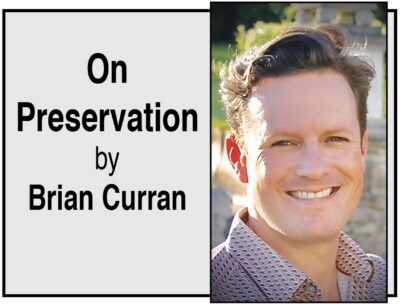On Preservation: They’re back! Spawn of SB50 lives on; the good, bad, ugly
 After the collapse of the California Senate’s 2020 Housing Package in November of last year, the seeds of a new attack on the will of Californians to determine their own local housing policy were planted at the end of the last session of the Legislature. The failure to pass SB902 was the third strike in Sen. Scott Wiener’s attempts to end single-family zoning in California as a means to punish single-family residents and enable developers to profit by meeting demand for market rate housing in California.
After the collapse of the California Senate’s 2020 Housing Package in November of last year, the seeds of a new attack on the will of Californians to determine their own local housing policy were planted at the end of the last session of the Legislature. The failure to pass SB902 was the third strike in Sen. Scott Wiener’s attempts to end single-family zoning in California as a means to punish single-family residents and enable developers to profit by meeting demand for market rate housing in California.
Wiener’s previous attempts with SB827 (2018) and SB50 (2019) also did not pass. But sure as weeds that shoot up in spring, a new Senate Housing Package for 2021 was crafted in December and now has taken root. Like a weed, the package is fronted with a pleasant bloom of beneficence and creative thinking, but that masks a root system whose effect, if not intention, is to undermine local planning and control (while not leading to any meaningful increase in needed affordable housing). Quotations describing the new bills come right from their advocates’ press release (focus.senate.ca.gov/housing).
The Good
SB5 (Atkins, Caballero, McGuire, Roth, Rubio, Skinner, Wiener) “establishes the initial framework for a statewide housing bond that would fund the creation of new, affordable housing for homeless and low-income families.” Dissolving the Community Redevelopment Agencies throughout the state in 2010 left a gaping hole in funding for the production of affordable housing, leaving it to inclusionary zoning and density bonuses to take up the slack. The results have been less than sufficient. If passed by the Legislature, California voters could see an Affordable Housing Bond on the November 2022 ballot, with greater funding for affordable housing becoming available if the bond passes.
SB6 (Caballero) “authorizes residential development on existing lots currently zoned for commercial office and retail space such as strip malls or large big box retail spaces. The bill requires the development of residential units be at a minimum density to accommodate affordable housing and abide by existing local planning and development ordinances.” Again a wise bill which combines smart planning, affordable housing and local input.
The Bad
SB7 (Atkins) “seeks to improve the California Environmental Quality Act (CEQA) process by extending and expanding provisions of AB900, which streamlined paperwork and expedited legal challenges to large, multi-benefit housing, energy, and manufacturing projects.” By “improving” CEQA, this bill means gutting it, providing a major giveaway to developers in exchange for a few affordable units.
SB8 (Skinner) This bill slightly alters the state’s Density Bonus law that requires that qualifying projects set aside 20 percent of units for low- to moderate-income renters. The existing law has been criticized for not requiring more affordable housing for the bonus received, thus providing only an anemic amount of bang for the buck.
And the Ugly
SB9 (Atkins) “promotes small-scale neighborhood residential development by streamlining the process for a homeowner to create a duplex or subdivide an existing lot in residential areas.” The long hand of Wiener and his attempts to end single-family zoning appear in this bill, a copycat of SB1120 that failed last November. It effectively ends single-family zoning, allowing a property owner to divide his or her property in half, build a duplex on both lots with two additional ADUs (Accessory Dwelling Units) for a total of eight units where previously a single-family house stood. See unitedneighbors.net for extensive information about this threat, including helpful drawings.
SB10 (Wiener) “allows cities to upzone areas close to job centers, transit, and existing urbanized areas to allow up to 10 units without having to go through the lengthy CEQA process.” This year’s version of Wiener’s failed SB902 would allow the city to override zoning to approve a 10-unit apartment building on any urban infi ll site or any parcel within a loosely defined “jobs-rich” or “transitrich” area, without provision for any affordable housing. The entire readership area of the Larchmont Chronicle would be affected. For more information, see tinyurl.com/5avuc5tt.
While I applaud the California Senate for adding some sweeteners to this bitter package, what nonetheless remains clear is that again Sacramento’s response to the housing crisis is to try to increase housing supply by abolishing single-family zoning, circumventing CEQA, and hoping developers will solve the affordable housing crisis, no matter how many times the legislators are told by their constituents NO.
By Brian Curran
Category: Real Estate

Excellently written, Mr. Curran. Thank you.
This is incredibly selfish. Your city needs more housing and you are trying to distort the truth to fit your agenda. You can’t support affordable housing and single-family-only zoning, the two are antithetical.
90% of Larchmont homes were built before 1990; almost 50% were built before 1940! Meanwhile, only 16% of residents own their home vs 83% renters. https://www.point2homes.com/US/Neighborhood/CA/Los-Angeles/Larchmont-Demographics.html
Your city shouldn’t be making decisions that cater to that 16% over the rest just because the homeowner class has the freedom and time to be most vocal.
And Brian should stop pretending to care about housing affordability and just plainly state he’s more concerned about his portfolio than equity and stability for all California residents.